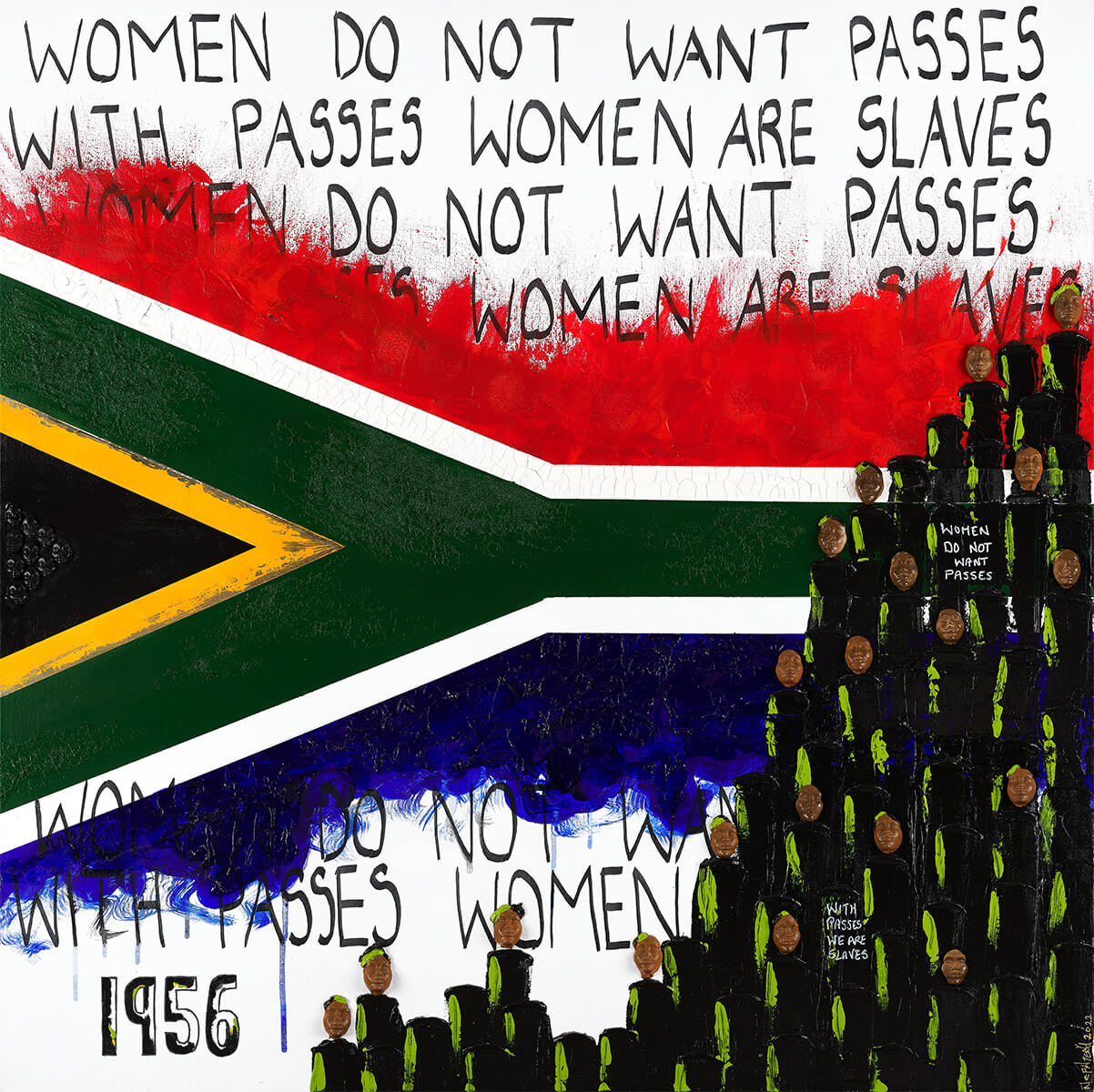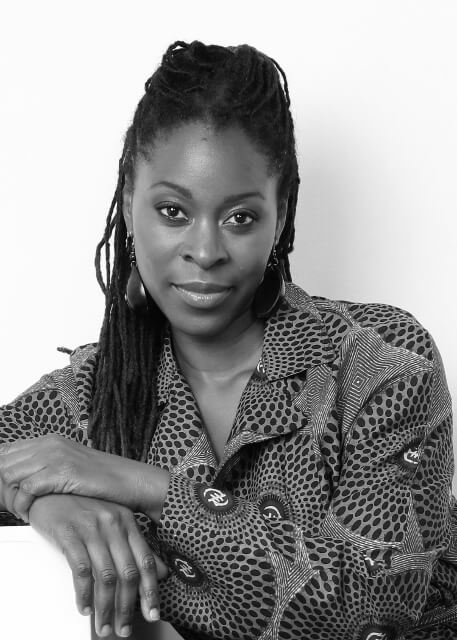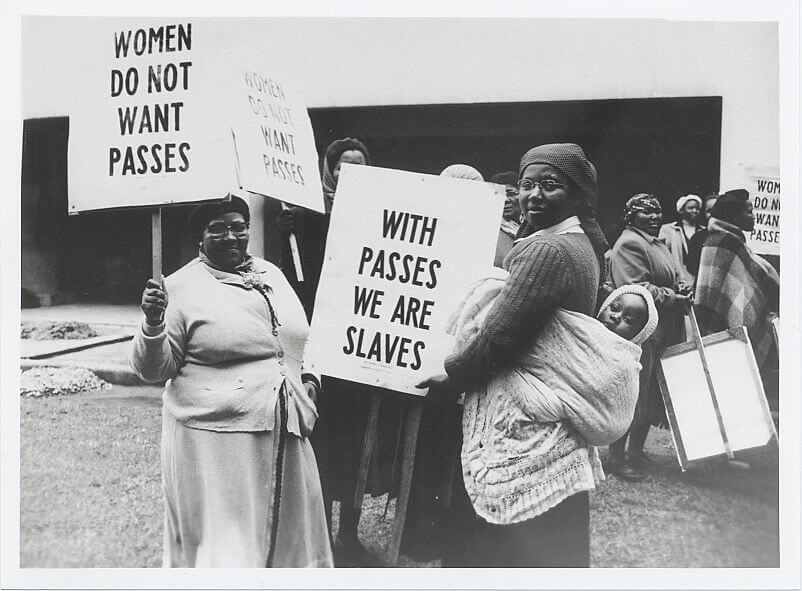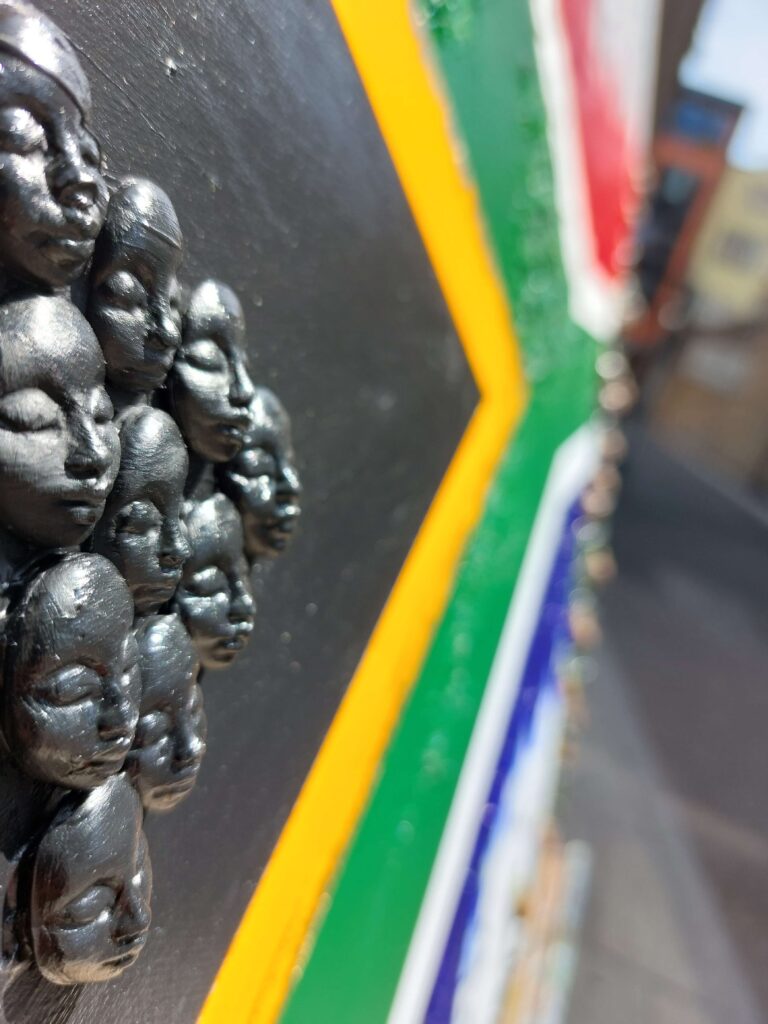Commission Number 2 responding to themes raised by the action of women during the 1956 March to Pretoria’s Union Buildings
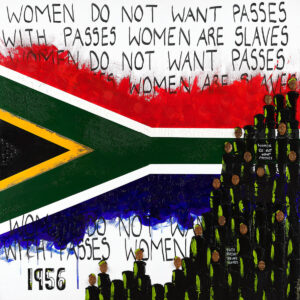 To symbolize the ongoing inequalities between men and women within global societies, Nefateri Asantewa’s commissioned piece featured a cracked and textured South African flag. A series of 3D faces of women were included in the mixed media piece (clay and paint on canvas), highlighting the struggle of women now and in the past. The 20 faces give reference to the over 20,000 women who took part in the 1956 Women’s March in Pretoria, South Africa, now annually celebrated as South African Women’s Day on August 9th. Messages written on the protestors’ posters in 1956 continue to resonate with the struggle of women against inequalities, then and now.
To symbolize the ongoing inequalities between men and women within global societies, Nefateri Asantewa’s commissioned piece featured a cracked and textured South African flag. A series of 3D faces of women were included in the mixed media piece (clay and paint on canvas), highlighting the struggle of women now and in the past. The 20 faces give reference to the over 20,000 women who took part in the 1956 Women’s March in Pretoria, South Africa, now annually celebrated as South African Women’s Day on August 9th. Messages written on the protestors’ posters in 1956 continue to resonate with the struggle of women against inequalities, then and now.
The piece highlights some of the messages from that first march representing the ongoing struggle and the need for change. Nefateri is a self-taught mixed media artist and she unveiled her piece as part of our ‘Celebrating South African Women’s Day” event held on 9th August 2022.
Nefateri says that as an artist and a black woman, she uses her art as a tool to share messages of importance that she hopes touches the soul of those who see her work. This commission offered Nefateri the opportunity to respond creatively to the 1956 Women’s March and to surface how struggle against gender and other inequalities are still prevalent today on a global scale,
‘As a Black woman in the diaspora, I resonate with the Black women of South Africa and their plight to bring about change to uplift and empower women on a national and global scale. The importance of resilience and contribution are powerful messages in the continued struggle of gender-based inequality all over the world, and I would like to be a part of the solution for change.’
Nefateri was drawn to the commission because of the opportunity that it afforded to explore how the resilience of past peoples gives strength and depth to issues affecting Black people today. This notion has anchored her previous work, for example in pieces that explored and shone a light on the Zong massacre of the transatlantic slave trade as well as ‘blood diamonds’, which highlighted the mineral conflict and atrocities in Africa. Nefateri explains, “I am intuitively inspired to create art that shines a light on injustice, mental health and unspoken or hidden atrocities related to the African-Caribbean experience”. Nefateri explained how initially she knew very little about the specifics of the Women’s March in South Africa in 1956.
“Although as a young child around age nine I was mildly aware of apartheid and the injustices carried out towards black people, I don’t recall hearing or seeing the resistance to imposed laws”.
She spent time researching archival materials to inform herself around the effects of apartheid on women and more specifically, the South African women’s struggle during the time of the protest in 1956, and used this information to identify factors that would be relevant in the final piece. This included the text that was written on the boards that the women were holding up and also the colour of their clothing – the colours of the ANC.
She says, ‘The steps that I took to create the work included creating a smaller version of the final piece so that I was happy with the composition and information portrayed in the artwork. Then I had to prepare the canvas for painting, which meant that a generous coating of gesso [paint primer] was used. I then practiced drawing and painting the flag of South Africa before finally transforming it into an artistic version of the flag.
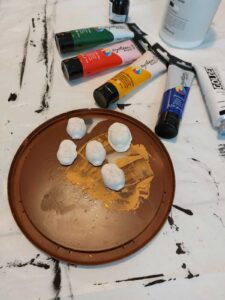 The most time consuming aspect of the process, Nefateri says, was making moulds of the women’s faces that would be used in the piece to represent the 20,000 women that took part in the march. She summed up her work to this point saying,
The most time consuming aspect of the process, Nefateri says, was making moulds of the women’s faces that would be used in the piece to represent the 20,000 women that took part in the march. She summed up her work to this point saying,
“During this process, I am discovering that I am able to use a brief to complete a commissioned piece of work. Generally, when creating my art, it comes to me through a more spiritual connection. My process is usually much more intuitive. However, I found that after doing the research and understanding more of what the brief was asking, I was then able to once again connect with my inner self and create a vision of the final piece, before bringing it to life on the canvas.”
Nefateri found the research process very informative, she was particularly interested to learn about the process that led to the creation of a new flag as part of the negotiation process to a democratic South Africa.
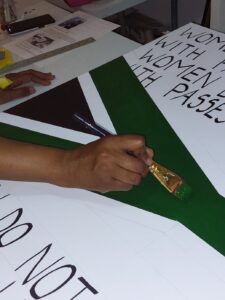 The South African flag incorporates elements of both the Apartheid government and the African National Congress’s (ANC) flags. Colours from the old South African flag were red, white and blue and the colours from the ANC flag were green, black and yellow. The flag is representative of the country’s long struggle for freedom, as well as the country’s diversity. The colours themselves have their own symbolism and these can be interpreted subjectively by the viewer. For Nefateri and many others, the black symbolises the people of South Africa, green represents the land and gold represents the mineral and other natural wealth of South Africa.
The South African flag incorporates elements of both the Apartheid government and the African National Congress’s (ANC) flags. Colours from the old South African flag were red, white and blue and the colours from the ANC flag were green, black and yellow. The flag is representative of the country’s long struggle for freedom, as well as the country’s diversity. The colours themselves have their own symbolism and these can be interpreted subjectively by the viewer. For Nefateri and many others, the black symbolises the people of South Africa, green represents the land and gold represents the mineral and other natural wealth of South Africa.
Nefateri was keen for her audiences to imagine what each colour in the flag represents and provoked this by using several types of texture in the work and her own artistic representation of the women’s faces, “texture plays a big role in my art, as it supports the feelings and emotions of the artwork.” She also wanted people to know about the bravery and significance of the women who took part in the rally against the draconian ‘Pass’ laws during the apartheid regime and therefore to really grasp what the women were fighting for.
“It was great knowing that the women had the courage then, even amongst all that was going on, to challenge the system and fight for their rights. This is very empowering and is still the case in struggles and challenges that we experience today”.
For Nefateri, researching archival material presented her with a new way of going about her artistic process. Usually when creating work, she sees a vision in her mind and puts that onto the canvas straight away without having to sketching it out. She says that this project challenged her to prepare the work before starting, ‘I used to be scared of getting a commission in case it didn’t turn out the way the commissioners wanted it, however I really enjoyed this commission and documenting my development as I went along was very satisfying and will remain a constant reminder of how the piece was created.’
Reflecting on how the commission, Nefateri explained that it has impacted her personally as well as her artistic practice, saying that she felt honoured to be a black woman living today,
‘I am inspired to know that there are great women among us who still continue to be a beacon of light in the lives of others, especially those who are game changers and continue to reshape the world to be a much more positive lived experience. As an artist, I have taken away a deep sense of knowing that I have the ability to create work that has important messages and create art, I hope, that continues to touch the Soul.’


